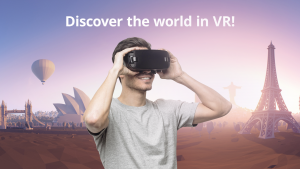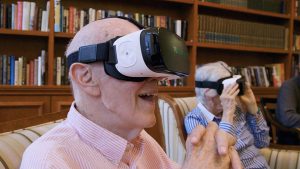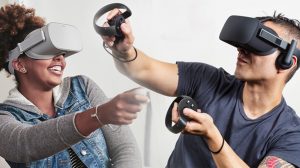
Shownotes
Welcome to Day 1463 of our Wisdom-Trek, and thank you for joining me.
This is Guthrie Chamberlain, Your Guide to Wisdom
Virtual Reality - What We Can Expect – Ask Gramps
Wisdom - the final frontier to true knowledge. Welcome to Wisdom-Trek! Where our mission is to create a legacy of wisdom, to seek out discernment and insights, to boldly grow where few have chosen to grow before. Hello, my friend, I am Guthrie Chamberlain, your captain on our journey to increase Wisdom and Create a Living Legacy. Thank you for joining us today as we explore wisdom on our 2nd millennium of podcasts. Today is Day 1463 of our Trek, and our focus on Fridays is the future technological and societal advances, so we call it Futuristic Fridays. My personality is one that has always been very future-oriented. Since my childhood, I have yearned for the exploration and discovery of new technologies and advancements for the future. I grew up with the original Star Trek series, and even today, while I am on my 64th revolution around the sun, I still dream of traveling in space. Each week we will explore rapidly converging technologies and advancements, which will radically change our lives. At times, the topics may sound like something out of a science fiction novel, but each area that we explore is already well on its way of becoming a reality over the next couple of decades.
To keep with our theme of “Ask Gramps,” I will put our weekly topics in the form of a question to get us on track. So this week’s question is, Hey Gramps, I hear a lot about Virtual Reality recently. Can you share your insight about where the Virtual Reality market is today, and what we can expect over this next decade?
Virtual Reality – What We Can Expect
Last week we focused on the second part of how exponential technologies are impacting food production. This week we are switching our focus to Virtual Reality and the road from deceptive to disruptive. I am using some of the information mentioned in Peter Diamandis’s blogs and book “The Future is Faster Than You Think.”
In 2016, venture investments in Virtual Reality exceeded $800 million, while Augmented Reality, which is also referred to as Mixed Reality, received a total of $450 million. Just a year later, investments in AR/MR and VR startups doubled to $3.6 billion.
Today, major players are bringing VR headsets to market that have the power to revolutionize the industry, as well as countless others. Already, VR headset sales volumes are expected to reach 98.4 million by 2023, according to Futuresource Consulting. Beyond headsets themselves, Facebook’s $399 Oculus Quest brought in $5 million in content sales within the first two weeks post-release in the spring of 2019.
With companies like Niantic ($4B valuation), Improbable ($2B valuation), and Unity ($6B valuation) all exceeding a valuation exceeding $1 billion in recent years, the VR space is massively heating up.
Today we will dive into a brief history of VR, recent investment surges, and the future of this revolutionary technology.
· Brief History of VR
For all of history, our lives have been limited by the laws of physics and mitigated by the five senses, but Virtual Reality is rewriting those rules. It’s letting us digitize experiences and teleport our senses into a computer-generated world where the limits of imagination become the only brake on reality. Considering all of recorded history, it has taken a while to get here.
Much like Artificial Intelligence, the concept of VR has been around since the 60s. The 1980s saw the first releases of VR when the earliest “consumer-facing” systems began to show up. In 1989, if you had a spare $250,000, you could purchase the EyePhone before the iPhone, a VR system built by Jaron Lanier’s company VPL. It was actually Jaron Lanier who coined the term ‘virtual reality.’
Unfortunately, the computer that powered that system was the size of a dorm room refrigerator. At the same time, the headset it required was bulky, awkward, and only generated about five frames a second—six times slower than the average television of that era. By the early 1990s, the hype had faded, and VR entered a two-decade deceptive phase. Through the 2000s, the convergence of increasingly powerful game engines and AI-image rendering software flipped the script. Suddenly, deceptive became disruptive, and the VR universe opened for business.
By the early 1990s, the hype had faded, and VR entered a two-decade deceptive phase. Through the 2000s, the convergence of increasingly powerful game engines and AI-image rendering software flipped the script. Suddenly, deceptive became disruptive, and the VR universe opened for business.
· The Disruptive Phase: Surges in VR Investment
In 2012, Facebook spent $2 billion on Oculus Rift. By 2015, Venture Beat reported that an arena which typically saw only ten new entrants a year, suddenly had 234. In June 2016, HTC announced the release of its ‘Business Edition’ of the Vive VR headset for $1,200, followed six months later by their announcement of a tether-less VR upgrade.
A year later, Samsung cashed in on this shift, selling 4.3 million headsets and turning enough heads that everyone from Apple and Google to Cisco and Microsoft decided to investigate VR. Phone-based VR showed up soon afterward, dropping barriers to entry as low as $5. By 2018, the first wireless adaptors, standalone headsets, and mobile headsets hit the market.
Resolution-wise, 2018 was also when Google and LG doubled their pixels-per-inch count and increased their refresh rate from VPL’s five frames a second to over 120. Around the same time, the systems began targeting more senses than just vision. HEAR360’s “Omni-binaural” microphone suite captures 360 degrees of audio, which means the immersive sound has now caught up to immersive visuals.
Touch has also reached the masses, with haptic gloves, vests, and full-body suits hitting the consumer market. Scent emitters, taste simulators, and every kind of sensor imaginable—including brainwave readers—are all trying to put the “very” into verisimilitude.
The number of virtual explorers continues to mount. In 2017, there were 90 million active users, which nearly doubled to 171 million by 2018. YouTube’s VR channel has over three million subscribers. That number is growing. By the end of 2020, estimates put the VR market at $30 billion, and it’s hard to find a field that will be left untouched.
· Future of VR: Emotive and Immersive Education
 History class, 2030. This week’s lesson: Ancient Egypt. The pharaohs, the queens, the tombs—the full Tut. Sure, you’d love to see the pyramids in person and have your student join you. If you consider the cost of airfare, hotel rooms for the entire class, plus, taking two weeks off from school for the trip, and you quickly realize that this would never be possible. Worse, even if you could go, you couldn’t go. Many of Egypt’s tombs are closed for repairs, and definitely off-limits to a group of teenagers.
History class, 2030. This week’s lesson: Ancient Egypt. The pharaohs, the queens, the tombs—the full Tut. Sure, you’d love to see the pyramids in person and have your student join you. If you consider the cost of airfare, hotel rooms for the entire class, plus, taking two weeks off from school for the trip, and you quickly realize that this would never be possible. Worse, even if you could go, you couldn’t go. Many of Egypt’s tombs are closed for repairs, and definitely off-limits to a group of teenagers.
There is a solution, and VR solves these problems. In a VR world, you and your class can easily breach Queen Nefertari’s burial chamber, touch the hieroglyphics, even scramble atop her sarcophagus—impossible opportunities in physical reality. You also have a world-class Egyptologist as your guide.
Visiting Egypt, the pyramids, and the tomb doesn’t require waiting until 2030. In 2018, Philip Rosedale and his team at High Fidelity pulled off this exact virtual field trip. First, they 3D-laser scanned every square inch of Queen Nefertari’s tomb. Next, they shot thousands of high-resolution photos of the burial chamber. By stitching together more than ten thousand photos into a single vista, then laying that vista atop their 3D-scanned map, Rosedale created a stunningly accurate virtual tomb. Next, he gave a classroom full of kids HTC Vive VR headsets.
Because High Fidelity is a social VR platform, meaning multiple people can share the same virtual space at the same time, the entire class was able to explore that tomb together. In total, their fully immersive field trip to Egypt required zero travel time, zero travel expenses. VR will not only cover traditional educational content, but also expand our emotional education.
Jeremy Bailenson, founding director of Stanford’s Virtual Human Interaction Lab, has spent two decades exploring VR’s ability to produce real behavioral change. He’s developed first-person VR experiences of racism, sexism, and other forms of discrimination.
For example, experiencing what it would be like to be an elderly, homeless, African American woman living on the streets of Baltimore produces real change: A significant shift in empathy and understanding.
“Virtual reality is not a media experience,” explains Bailenson. “When it’s done well, it’s an actual experience. In general, our findings show that VR causes more behavior changes, causes more engagement, causes more influence than other types of traditional media.” Nor is empathy the only emotion VR appears capable of training. In research conducted at USC, psychologist Skip Rizzo has had considerable success using virtual reality to treat PTSD in soldiers. Other scientists have extended this to the full range of anxiety disorders.
VR, especially when combined with AI, has the potential to facilitate a top-shelf traditional education, plus all the empathy and emotional skills that traditional education has long been lacking.
When AI and VR converge with wireless 5G networks, our global education problem moves from the nearly impossible challenge of finding teachers and funding schools for the hundreds of millions in need, to the much more manageable puzzle of building a fantastic digital education system. The educational possibilities are available to millions worldwide for free to anyone with a headset. It’s quality and quantity on demand.
In the workplace, VR will serve as an efficient trainer for new employees. Ten thousand of Walmart’s 1.2 million employees have taken VR-based skills management tests. Learning modules that once took 35 to 45 minutes, now take 3 to 5. The company plans to train 1 million employees using the Oculus VR headset by the end of this year. The upfront costs of VR headsets will ultimately be recovered in labor efficiencies.
· Multiple Worlds, Multiple Economies
 We no longer live in only one place. We have real-world personae and online personae. This delocalized existence is only going to expand. With the rise of AR and VR, we’re introducing more layers to this equation.
We no longer live in only one place. We have real-world personae and online personae. This delocalized existence is only going to expand. With the rise of AR and VR, we’re introducing more layers to this equation.
You’ll have avatars for work and avatars for play, and all of these versions of ourselves are opportunities for new businesses. Consider the multi-million-dollar economy that sprung up around the very first virtual world, Second Life. People were paying other people to design digital clothes and digital houses for their digital avatars.
Every time we add a new layer to the digital strata, we’re also adding an entire economy built upon that layer, meaning we are now conducting our business in multiple worlds at once. The possible uses for VR are only left to our imagination, and we have yet to begin to scratch the surface.
Just think about the possibilities that we will have to walk where Jesus walked, and never leave your house. To stand on top of Mount Siani where Moses receieved the ten-commandments. To travel the same route that the Apostle Paul traveled. There are unlimited possibilities as we continue to use exponential technologies to build God’s kingdom on earth, as it is in heaven. The season of harvest is coming.
For everything there is a season,
a time for every activity under heaven.
That is a wrap for today’s question. Join us again next Futuristic Friday as we look at Flying Cars and Aerial Ridesharing on our ‘Ask Gramps’ episode. Our next trek is Meditation Monday, where we will help you reflect on what is most important in life. So encourage your friends and family to join us and then come along on Monday for another day of ‘Wisdom-Trek, Creating a Legacy.’ If you would like to listen to any of the past 1462 daily treks or read the associated journals, they are all available at Wisdom-Trek.com. I encourage you to subscribe to Wisdom-Trek on your favorite podcast player so that each day will be downloaded to you automatically.
If you would like to listen to any of the past 1462 daily treks or read the associated journals, they are all available at Wisdom-Trek.com. I encourage you to subscribe to Wisdom-Trek on your favorite podcast player so that each day will be downloaded to you automatically.
Thank you for allowing me to be your guide, mentor, and, most of all, your friend as I serve you in through this Wisdom-Trek podcast and journal.
As we take this Trek of life together, let us always:
- Live Abundantly (Fully)
- Love Unconditionally
- Listen Intentionally
- Learn Continuously
- Lend to others Generously
- Lead with Integrity
- Leave a Living Legacy Each Day
I am Guthrie Chamberlain….reminding you to ’Keep Moving Forward,’ ‘Enjoy your Journey,’ and ‘Create a Great Day…Everyday’! See you on Monday!